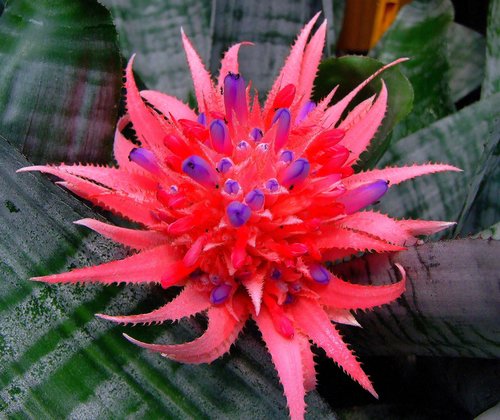Epiphytes: Difference between revisions
No edit summary |
|||
| Line 1: | Line 1: | ||
== Overview == | == Overview == | ||
Epiphytes, specifically vascular epiphytes, are those plants that germinate and take root on other plants. These plants generally exhibit commensal relationships with their host plants, and epiphytes can be both obligate and facultative | Epiphytes, specifically vascular epiphytes, are those plants that germinate and take root on other plants. These plants generally exhibit commensal relationships with their host plants, and epiphytes can be both obligate and facultative <ref name= "zotz">Zotz, Gerhard. (12 Nov 2012). "The systematic distribution of vascular epiphytes – a critical update." Botanical Journal of the Linnean Society. The Linnean Society of London. 171: 453–481. https://academic.oup.com/botlinnean/article/171/3/453/2416203.</ref>. Facultative epiphytes are plant species that grow terrestrially or epiphytically approximately the same amount across their distribution <ref name= "hoeber">Hoeber, V. and Zotz, G.. (15 Mar 2022). "Accidental epiphytes: Ecological insights andevolutionary implications." Ecological Monographs. The Ecological Society of America. 92(4): e1527. https://doi.org/10.1002/ecm.1527.</ref>. Plants that grow on other plants for only a portion of their life cycle are referred to as "hemi-epiphytes" <ref name= "nieder">Nieder, J., Prosperi, J., Michaloud, G.. (2001). "Epiphytes and their contribution to canopy diveristy." Plant Ecology. Kluwer Academic Publishers. 153: 51-63. https://www.researchgate.net/publication/226617674_Epiphytes_and_their_contribution_to_canopy_diversity.</ref>. Additionally "accidental epiphytes" can occur when a plant that does not usually grow epiphytically at any point in its life cycle does <ref name= "zotz">Zotz, Gerhard. (12 Nov 2012). "The systematic distribution of vascular epiphytes – a critical update." Botanical Journal of the Linnean Society. The Linnean Society of London. 171: 453–481. https://academic.oup.com/botlinnean/article/171/3/453/2416203.</ref>. Globally, epiphytes account for approximately 10 percent of all plant [[diversity]]. It is estimated that over 24,000 vascular plants are considered to be epiphytes, and these plants are most commonly concentrated in tropical areas, where they provide significant [[Ecosystem Services|ecosystem services]] <ref name= "nieder">Nieder, J., Prosperi, J., Michaloud, G.. (2001). "Epiphytes and their contribution to canopy diveristy." Plant Ecology. Kluwer Academic Publishers. 153: 51-63. https://www.researchgate.net/publication/226617674_Epiphytes_and_their_contribution_to_canopy_diversity.</ref>. | ||
[[File:bromeliad2.jpg|501px|thumb|left|Bromeliad <ref name= "pics">iNaturalist. https://www.inaturalist.org/.</ref>]] | [[File:bromeliad2.jpg|501px|thumb|left|Bromeliad <ref name= "pics">iNaturalist. https://www.inaturalist.org/.</ref>]] | ||
Revision as of 18:15, 27 March 2025
Overview
Epiphytes, specifically vascular epiphytes, are those plants that germinate and take root on other plants. These plants generally exhibit commensal relationships with their host plants, and epiphytes can be both obligate and facultative [1]. Facultative epiphytes are plant species that grow terrestrially or epiphytically approximately the same amount across their distribution [2]. Plants that grow on other plants for only a portion of their life cycle are referred to as "hemi-epiphytes" [3]. Additionally "accidental epiphytes" can occur when a plant that does not usually grow epiphytically at any point in its life cycle does [1]. Globally, epiphytes account for approximately 10 percent of all plant diversity. It is estimated that over 24,000 vascular plants are considered to be epiphytes, and these plants are most commonly concentrated in tropical areas, where they provide significant ecosystem services [3].

Ecology and Evolution
Ecologically, epiphytes are opportunistic, and most plants can display epiphytic growth in the correct conditions. Most epiphytes grow on tree crowns [2].
Common Terrestrial Epiphytes
References
- ↑ 1.0 1.1 1.2 Zotz, Gerhard. (12 Nov 2012). "The systematic distribution of vascular epiphytes – a critical update." Botanical Journal of the Linnean Society. The Linnean Society of London. 171: 453–481. https://academic.oup.com/botlinnean/article/171/3/453/2416203.
- ↑ 2.0 2.1 2.2 Hoeber, V. and Zotz, G.. (15 Mar 2022). "Accidental epiphytes: Ecological insights andevolutionary implications." Ecological Monographs. The Ecological Society of America. 92(4): e1527. https://doi.org/10.1002/ecm.1527.
- ↑ 3.0 3.1 3.2 Nieder, J., Prosperi, J., Michaloud, G.. (2001). "Epiphytes and their contribution to canopy diveristy." Plant Ecology. Kluwer Academic Publishers. 153: 51-63. https://www.researchgate.net/publication/226617674_Epiphytes_and_their_contribution_to_canopy_diversity.
- ↑ 4.0 4.1 iNaturalist. https://www.inaturalist.org/.